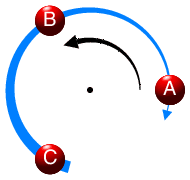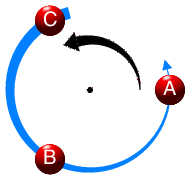 |
Screw Symmetry
III. Helical Screw Axes |
 |
Screw Symmetry
III. Helical Screw Axes |
Helical Screw Axes
The two-one axis illustrated previously is not the only type of screw axis that can be found within a crystal structure. A threefold rotation axis, for example, may be combined with either a translation of 1/3 or 2/3 of the repeat distance along the axis direction. These two types of screw axis are referred to as "three-one" and "three-two" axes, and have the crystallographic notation 31 and 32, respectively.
In contrast to two-one screw axes, three-one and three-two axes possess
a sense of handedness. Looking down the three-one axis, then the rotation
is seen as 120° anticlockwise and the translation is 1/3 of the
repeat distance (A to D) up the axis (as shown by the black arrows).
This is illustrated in the figure below where the length of the horizontal black
arrow corresponds to a translation length of 1/3 of the repeat distance
along the axis direction.
Starting with the red atom (A) on the far left of the diagram,
you should be able
to follow its movement along the axis as a result of repeated action
of the three-one screw symmetry operator (A to B to C to D to E to F to G).
The movement corresponds
to that of a right-handed helical screw as shown by the blue ribbon.
Note that it takes three times
31 to reach the middle (and equivalent) lattice position (D).
| 31 |
 |
 |
| View perpendicular to axis | View down axis |
| 32 |
 |
 |
| View perpendicular to axis | View down axis |
![]() The majority of the table is reference material.
The majority of the table is reference material.
In general, there exist crystallographic screw axes of the generic type n sub m, where n is the order of rotation, i.e. 2, 3, 4, or 6, m/n is the translation along the axis, and m < n, as shown in the table below:
| Order | Screw axes |
|---|---|
| 2 | 21 |
| 3 | 31, 32 |
| 4 | 41, 42, 43 |
| 6 | 61, 62, 63, 64, 65 |
|
© Copyright 1995-2006.
Birkbeck College, University of London.
|
Author(s):
Jeremy Karl Cockcroft Huub Driessen |